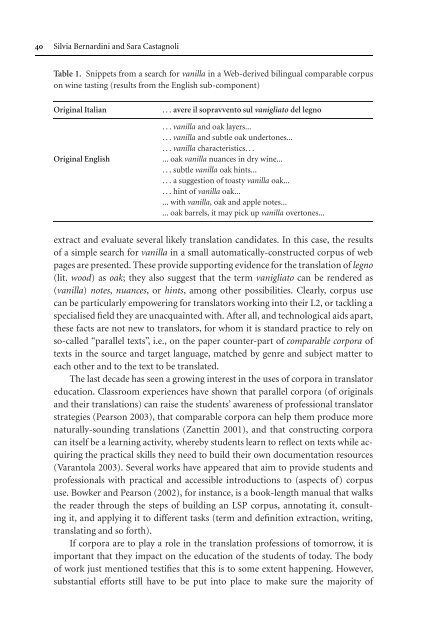Topics in Language Resources for Translation ... - ymerleksi - home
Topics in Language Resources for Translation ... - ymerleksi - home
Topics in Language Resources for Translation ... - ymerleksi - home
- No tags were found...
You also want an ePaper? Increase the reach of your titles
YUMPU automatically turns print PDFs into web optimized ePapers that Google loves.
40 Silvia Bernard<strong>in</strong>i and Sara CastagnoliTable 1. Snippets from a search <strong>for</strong> vanilla <strong>in</strong> a Web-derived bil<strong>in</strong>gual comparable corpuson w<strong>in</strong>e tast<strong>in</strong>g (results from the English sub-component)Orig<strong>in</strong>al ItalianOrig<strong>in</strong>al English...avere il sopravvento sul vanigliato del legno...vanilla and oak layers......vanilla and subtle oak undertones......vanilla characteristics. . .... oak vanilla nuances <strong>in</strong> dry w<strong>in</strong>e......subtlevanilla oak h<strong>in</strong>ts.... . . a suggestion of toasty vanilla oak......h<strong>in</strong>tofvanilla oak...... with vanilla, oak and apple notes...... oak barrels, it may pick up vanilla overtones...extract and evaluate several likely translation candidates. In this case, the resultsof a simple search <strong>for</strong> vanilla <strong>in</strong> a small automatically-constructed corpus of webpages are presented. These provide support<strong>in</strong>g evidence <strong>for</strong> the translation of legno(lit. wood) asoak; they also suggest that the term vanigliato can be rendered as(vanilla) notes, nuances, orh<strong>in</strong>ts, among other possibilities. Clearly, corpus usecan be particularly empower<strong>in</strong>g <strong>for</strong> translators work<strong>in</strong>g <strong>in</strong>to their L2, or tackl<strong>in</strong>g aspecialised field they are unacqua<strong>in</strong>ted with. After all, and technological aids apart,these facts are not new to translators, <strong>for</strong> whom it is standard practice to rely onso-called “parallel texts”, i.e., on the paper counter-part of comparable corpora oftexts <strong>in</strong> the source and target language, matched by genre and subject matter toeachotherandtothetexttobetranslated.The last decade has seen a grow<strong>in</strong>g <strong>in</strong>terest <strong>in</strong> the uses of corpora <strong>in</strong> translatoreducation. Classroom experiences have shown that parallel corpora (of orig<strong>in</strong>alsand their translations) can raise the students’ awareness of professional translatorstrategies (Pearson 2003), that comparable corpora can help them produce morenaturally-sound<strong>in</strong>g translations (Zanett<strong>in</strong> 2001), and that construct<strong>in</strong>g corporacan itself be a learn<strong>in</strong>g activity, whereby students learn to reflect on texts while acquir<strong>in</strong>gthe practical skills they need to build their own documentation resources(Varantola 2003). Several works have appeared that aim to provide students andprofessionals with practical and accessible <strong>in</strong>troductions to (aspects of) corpususe. Bowker and Pearson (2002), <strong>for</strong> <strong>in</strong>stance, is a book-length manual that walksthe reader through the steps of build<strong>in</strong>g an LSP corpus, annotat<strong>in</strong>g it, consult<strong>in</strong>git, and apply<strong>in</strong>g it to different tasks (term and def<strong>in</strong>ition extraction, writ<strong>in</strong>g,translat<strong>in</strong>g and so <strong>for</strong>th).If corpora are to play a role <strong>in</strong> the translation professions of tomorrow, it isimportant that they impact on the education of the students of today. The bodyof work just mentioned testifies that this is to some extent happen<strong>in</strong>g. However,substantial ef<strong>for</strong>ts still have to be put <strong>in</strong>to place to make sure the majority of
















